Episodes

Wednesday Sep 29, 2021
Wednesday Sep 29, 2021
This week, Chris interviews the incredible India Ochs! India is a brilliant social justice advocate, lawyer, educator, and board member for USSAAC and ISSAC who is also a lifelong AAC user. India describes her incredible journey with AAC, how she has used her many skills to advocate for social justice, why she volunteers so much of her time to the disabled community, and what she sees are the impacts of systemic racism on the field AAC (e.g. lack of vocabulary words to talk about racism).
Before the interview, Chris and Rachel respond to several comments from listeners about their recent banter about PECS. Some listeners said PECS works for them while robust AAC doesn’t work for them. Chris and Rachel note that, if robust AAC hasn’t worked, maybe the implementation hasn’t been done in a systematic way. They also respond to the idea that PECS is a necessary stepping stone to robust AAC, and provide some strategies for demonstrating early success with robust AAC when it doesn’t look like AAC is “working” yet.
Key ideas this week:
🔑 While the systematic nature of PECS implementation can encourage some people who would like a step-by-step guide, in some cases it causes students to “stall out” at a particular stage because they are required to demonstrate certain skills before moving on the next skill.
🔑 A simple paper and pen can be the most effective form of AAC for some literate AAC users.
🔑 It is difficult to find symbols for words like racism, anti-racism, African-American, Black person, hispanic, Martin Luther King, Jr on many AAC devices. Developers need to bring in experts on Black history and anti-racism to tell us what vocabulary we need to add to our devices.
Help us develop new content and keep the podcast going strong! Support our podcast at patreon.com/talkingwithtech!
To listen to this episode, search "Talking with Tech" in your podcast player of choice or go to www.talkingwithtech.org/episodes/india-ochs
Links from the episode:
AAC Speaker Connection: https://speaker.ussaac.org/
Silent Auction benefiting USSAAC that ends October 15th:
https://www.silentauctionpro.com/bidonlinegrid.php?groupId=1860
or email Virtualauction@ussaac.org
India's Blog: https://intrepidoaks.com/
Xceptional AAC Leaders Book with Chapter by India
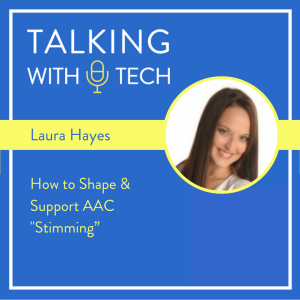
Wednesday Sep 22, 2021
Wednesday Sep 22, 2021
This week, Rachel interviews SLP and AAC Facilitator Laura Hayes! Laura recently did a presentation on AAC in the Cloud on AAC “stimming” and how we can best support AAC users who choose to press a button or series of buttons repeatedly. Laura shares that, If a person using AAC is “stimming”, ask yourself “how can I shape what we are doing” (e.g. teach a lesson on the word they are pressing) rather than just trying to extinguish the behavior.
Before the interview, Chris and Rachel discuss a listener question, who asked for ideas on how to become a better communicator and presenter in a conference setting. Chris and Rachel share lots of tips on presenting to others, including the importance of making it interactive, asking reflective questions to the audience, showing vs telling, and why often less is more.
Key ideas this week:
🔑 “Stimming” means different things to different people in the context of AAC devices. Laura found this behavior had 4 main purposes: babbling/exploration; exploratory perseveration; self regulation through audio/visual/tactile components, and/or scripting/echolalia.
🔑 If a person who uses AAC is disrupting a classroom because they are pressing buttons on their device while others are talking, teach the student to turn on “whisper mode” to make the device quieter.
🔑 According to Alexandria Zachos of meaningfulspeech.com, as many as 75% of autistic individuals are gestalt language processors, i.e., they process chunks of language without distinction between individual words.
You can reach Laura on Instagram @aac_innovations or via email at aacinnovations01@gmail.com.
Help us develop new content and keep the podcast going strong! Support our podcast at patreon.com/talkingwithtech!
Visit talkingwithtech.org to access previous episodes, resources, and CEU credits that you can earn for listening to TWT episodes!

Wednesday Sep 15, 2021
Wednesday Sep 15, 2021
This week, we hear from Part 3 of TWT Live - Closing the Gap 2020. This week’s portion of TWT Live has lots of helpful ideas for communication with families, coaching, motivating students, advocating for high-tech AAC with clinicians who always start with PECS, and more!
Before the interview, Chris shares about his recent experience as “Shadow the Labrador”, a mascot at a local school. He and Rachel discuss why we need to be the zaniest person in the room sometimes to get people motivated to talk. They also discuss a situation Chris was in recently where he wasn’t sure if he should ask for compensation for consulting with a company about their newest new technology tool. Rachel gives Chris some tips about asking for compensation and strategies she uses in negotiations.
If you would like to listen to Part 2 of this presentation, you can listen at talkingwithtech.org/episodes/twt-live-ctg-2
Key ideas this week:
🔑 If you have limited enthusiasm in your district for AAC, try finding teachers and/or staff who are excited about using technology in their curriculum and start working with them first.
🔑 What motivates a person can change over time. Periodically, do a preference assessment with your students to maximize motivation.
🔑 Have students give you directions on what to do (e.g. drink water) using their device - a lot of times, students are told what to do all day, and turning the tables can be motivating
Help us develop new content and keep the podcast going strong! Support our podcast at patreon.com/talkingwithtech!
To listen to this episode, search "Talking with Tech" in your podcast player of choice or go to www.talkingwithtech.org/episodes/twt-live-ctg-3
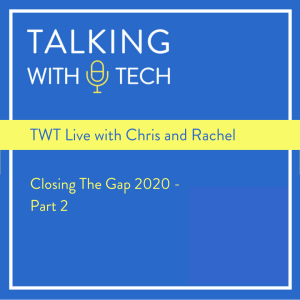
Thursday Sep 09, 2021
Thursday Sep 09, 2021
This week, the TWT team presents part 2 of Talking with Tech Live: Closing the Gap! This week, Rachel and Chris discuss several topics with the audience, including personal core /key vocabulary, the importance of literacy, and overcoming barriers to high-tech AAC in school districts.
If you would like to listen to Part 1 of this presentation, you can listen at talkingwithtech.org/episodes/twt-live-ctg-1
Before Part 2, Rachel and Chris discuss PECS in greater detail, including why motor planning is so important when comparing PECS to other AAC options, the consensus among experts that Chris and Rachel trust about PECS vs. more robust AAC, and why choosing robust AAC has the least chance of harming the client.
Key ideas this week:
🔑 Without the benefit of a motor plan, using PECS to communicate can be more fatiguing than using more robust AAC. For some of Rachel’s clients, making limited progress on PECS made the family resistant to other AAC options later on.
🔑 When making a difficult decision between strategies as clinicians (e.g. PECS vs robust AAC for a client with some verbal skills), we should choose the intervention with the lowest chance of doing harm. If we assume the client will will need AAC in some form forever, the time spent teaching PECS could have been better spent learning motor plans on a robust AAC device.
🔑 If we are trying to help teachers and admins embrace robust AAC, you can point to the abuse and neglect statistics for people with disabilities. Teaching language through robust communication systems gives students a better tool to future abuse and neglect in the future.
Help us develop new content and keep the podcast going strong! Support our podcast at patreon.com/talkingwithtech!
Visit talkingwithtech.org to access previous episodes, resources, and CEU credits that you can earn for listening to TWT episodes!
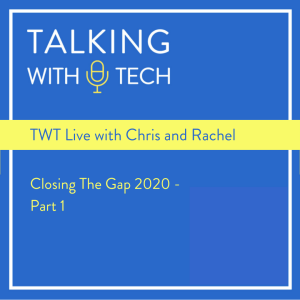
Wednesday Sep 01, 2021
Wednesday Sep 01, 2021
This week, we share Chris and Rachel’s presentation from last year’s Closing the Gap called “Brainstorming Solutions to Real-Life AAC Questions”. During this week’s Part 1 episode, Chris and Rachel share about evaluating evidence-based practices, when to consider “verbal” clients for AAC, how to determine when someone is ready for AAC, and more!
Before the interview, Chris and Rachel discuss ABA therapy and why working with ABA therapists can be very helpful in some cases, but difficult in others. Rachel shares about working with an ABA team that refuses to follow suggestions about working with her client’s AAC device, and how that has impacted her client’s progress using AAC. Chris also shares his three questions that he asks himself before employing a strategy like AAC:
Is it research based?
What are professionals saying?
What are the people who are using the strategy saying worked for them?
Chris notes that, in particular, the last question can be very important. Chris wonders whether the people who are getting ABA are saying “thank you” afterwards for the intervention.
Key ideas this week:
🔑 Consider AAC when someone has a high level of scripted phrases - AAC can be a great way to build novel generative language skills. Build vocabulary skills with more abstract language concepts.
🔑 Just because someone has speech some of the time doesn’t mean they have speech all of the time. AAC can be a great backup for people who have inconsistent difficulty with expressive language.
🔑 There are no prerequisites for high-tech AAC - people learn to use AAC when they are given the time and the oppertunity to learn it.
Help us develop new content and keep the podcast going strong! Support our podcast at patreon.com/talkingwithtech!
Visit talkingwithtech.org to access previous episodes, resources, and CEU credits that you can earn for listening to TWT episodes!
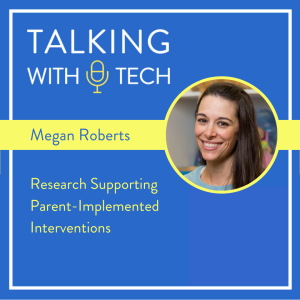
Wednesday Aug 25, 2021
Wednesday Aug 25, 2021
This week, Rachel interviews Megan Roberts, an Associate Professor and SLP at Northwestern University. Megan started the Early Intervention Research Group, where she researches early parent-implemented interventions for children with hearing loss, autism, and developmental language disorders. Megan has lots to share about her research behind parent-implemented interventions, early behaviors that are a predictors of autism, and how to approach conversations with parents about their child's possible autistic-like behaviors.
Before the interview, Chris and Rachel discuss a listener’s email about a difficult situation with an administrator. When the listener requested a high-tech AAC device for a minimally-verbal student, her school administrator told her she needed to give him low-tech AAC, because there was no way to get the student high-tech AAC. Rachel and Chris talk about how this administrator was stepping out of their role, and how Rachel and Chris would approach the situation to push back against this.
Key ideas this week:
🔑 Megan’s most robust predictor of autism in her assessments have been the presence of contact gestures, e.g., the person uses another person’s body part as a tool.
🔑 When we notice possible signs of autism in a young child and want to discuss this with parents, focus on identifying the behaviors that might interfere with learning rather than the “autism” label. Then, you can “wonder” about those behaviors with the parent, how they might impact the student, and how these maladaptive behaviors might be suppressed via intervention.
🔑 Girls with autism can present very differently than boys with autism early in their development - we need more research to better define what the differences are.
Help us develop new content and keep the podcast going strong! Support our podcast at patreon.com/talkingwithtech!
Visit talkingwithtech.org to access previous episodes, resources, and CEU credits that you can earn for listening to TWT episodes!

Thursday Aug 19, 2021
Thursday Aug 19, 2021
This week, Rachel interviews Amanda Soper, AT Specialist, SLP, and Professor at Gallaudet University. She supports, among others, people with cortical visual impairment (CVI) who also use AAC. Amanda shares from her experiences working with CVI, including: how she teaches vocabulary, the importance of reducing visual complexity in the environment, talking through navigation, and the three main red flags for CVI:
You notice there is something not quite right about a child’s functional vision. There is nothing structurally wrong with their eye, but they are having vision problems.
There is a medical history of neurological conditions, such as a lack of oxygen to the brain, or chromosomal disorders.
10 visual behaviors that characterize a person with CVI’s vision, including: need for movement, color preference, visual field deficits, absence of visually-guided reach, and difficulty with visual complexity.
Learn more about Amanda’s strategies at http://www.aacreatively.com/. You can email her at amandasoperslp@gmail.com
Key ideas this week:
🔑 Pull students out of class when introducing a new device or a new overlay, because the complexity of the class environment can make it more difficult to understand the new symbols.
🔑 When using AAC with someone who has CVI, you can talk through the navigation when you are introducing new vocabulary to help them track and follow. (“press the red apple, then the blue man”)
🔑 Try and teach AAC vocabulary to a person with CVI in context, like working on “fork” during eating time.
Help us develop new content and keep the podcast going strong! Support our podcast at patreon.com/talkingwithtech!
Visit talkingwithtech.org to access previous episodes, resources, and CEU credits that you can earn for listening to TWT episodes!

Wednesday Aug 11, 2021
Wednesday Aug 11, 2021
This week, Chris interviews school-based AT Specialists Amy Fleischer and Melissa Petersen! Amy and Melissa share lessons they have learned about putting universal supports in place, including universal core boards in Melissa’s district. They discuss many of the reasons why Melissa wanted to put a universal core board in place, how her district decided on what words to include, and the improvements she has seen in overall AAC implementation since that time. You can view the website she made for her district here.
Before the interview, Rachel and Chris discuss a recent trip Chris took to visit his cousins and all of the visiting with his family. Chris shares about tempting his young relatives with fun games, and then waiting for them to come over on their own, and relates that to motivating AAC users with a “tempt and pause”.
Key ideas this week:
🔑 When Melissa made a low-tech support universal, teachers who were previously afraid of technology said they felt more confident with the core board. This helped them to focus more on modeling and descriptive teaching, and less on the technology.
🔑 Putting the district logo on their universal core board helped Melissa to get buy in from some teachers and staff - they said it make the board look more “official”.
🔑 If we want communication partners to take on extra responsibility via coaching, it helps to give them resources they can pick up and run with. A great way to do this is with a low-tech board, because we are giving them something inexpensive they can go out today and start using with students.
Help us develop new content and keep the podcast going strong! Support our podcast at patreon.com/talkingwithtech!
Visit talkingwithtech.org to access previous episodes, resources, and CEU credits that you can earn for listening to TWT episodes!
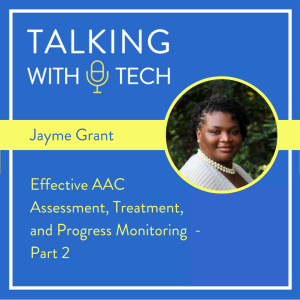
Thursday Jul 22, 2021
Thursday Jul 22, 2021
This week, we share Part 2 of Chris’s interview with Jayme Grant. Jayme is an Educational Technology and Assistive Technology Specialist in Beaufort, South Carolina who wanted to interview Chris about AAC and Assistive Technology. In Part 2, Chris and Jayme discuss obtaining funding for AAC and AT, shifting away from a direct therapy model for AAC users, monitoring progress, and more!
Before the interview, Chris and Rachel finish up answering some questions from one of our Patreon users about changing the mindset of AAC communication partners. In this listener’s school district, classroom staff appear more interested in AAC assessment than AAC implementation. Rachel and Chris share why it can be helpful to break coaching sessions up into smaller “bites” and how to reduce the negative impact of staff turnover on AAC users by coaching family members as well as school staff.
Key ideas this week:
🔑 School should be an opportunity to get kids excited about things they never would have been excited about in the first place. SLPs can benefit from fun activities in therapy, because we can get students to talk more about things they are interested in.
🔑 Mindset is the most important first step in a successful implementation. Many people who work with people with disabilities start with a mindset that a student must prove they can use AAC before we give them AAC and help them learn to use it. We must help them see the AAC user’s potential before we move on to assessment or implementation.
🔑 When measuring progress of AAC users, don’t measure how much he or she uses the AAC tool, measure whether or not the desired outcome was achieved. It is difficult to say if the AAC tool we provided is the total reason someone is communicating more, or if it is a combination of factors. By measuring the outcome, you don’t have to worry how much the AAC device was the cause.
Visit talkingwithtech.org to access previous episodes, resources, and CEU credits that you can earn for listening to TWT episodes!
To listen to this episode, search "Talking with Tech" in your podcast player of choice or go to www.talkingwithtech.org/episodes/jayme-grant-2

Wednesday Jul 14, 2021
Wednesday Jul 14, 2021
This week, we share Part 1 of Chris’s interview with Jayme Grant. Jayme is an Educational Technology and Assistive Technology Specialist in Beaufort, South Carolina who wanted to interview Chris. The resulting interview is packed with useful tips and ideas for improving AAC assessment and implementation!
Before the interview, Chris and Rachel discuss more questions from a Patreon user about how to change the mindset and culture surrounding AAC in her district. Rachel and Chris talk about coaching teachers to use core words to describe fringe words, why we shouldn’t create temporary pages for specific activities or academic topics, and more!
Key ideas this week:
🔑 Rather than add academic vocabulary to a device that will only be used for a particular lesson or unit, try coaching the team to describe academic words using core words. This helps teach core words and doesn’t create temporary folders and additional fringe vocabulary words, which can interfere with motor planning.
🔑 Technology is a tool, not a quick fix. Make sure the team understands that giving a device to someone is only the beginning. Parents sometimes demand a device without understanding the work that goes along with teaching how to use this tool.
🔑 During assessment, consider having a team member, such as a teacher, describe what they want a potential AAC user to be able to do with the device long term. Even better, consider collaborating with a variety of communication partners to determine AAC needs. Collaboration amongst the team on assessment can help avoid disagreements later about the decisions that were made about device selection and implementation.
Help us develop new content and keep the podcast going strong! Support our podcast at patreon.com/talkingwithtech!
Visit talkingwithtech.org to access previous episodes, resources, and CEU credits that you can earn for listening to TWT episodes!
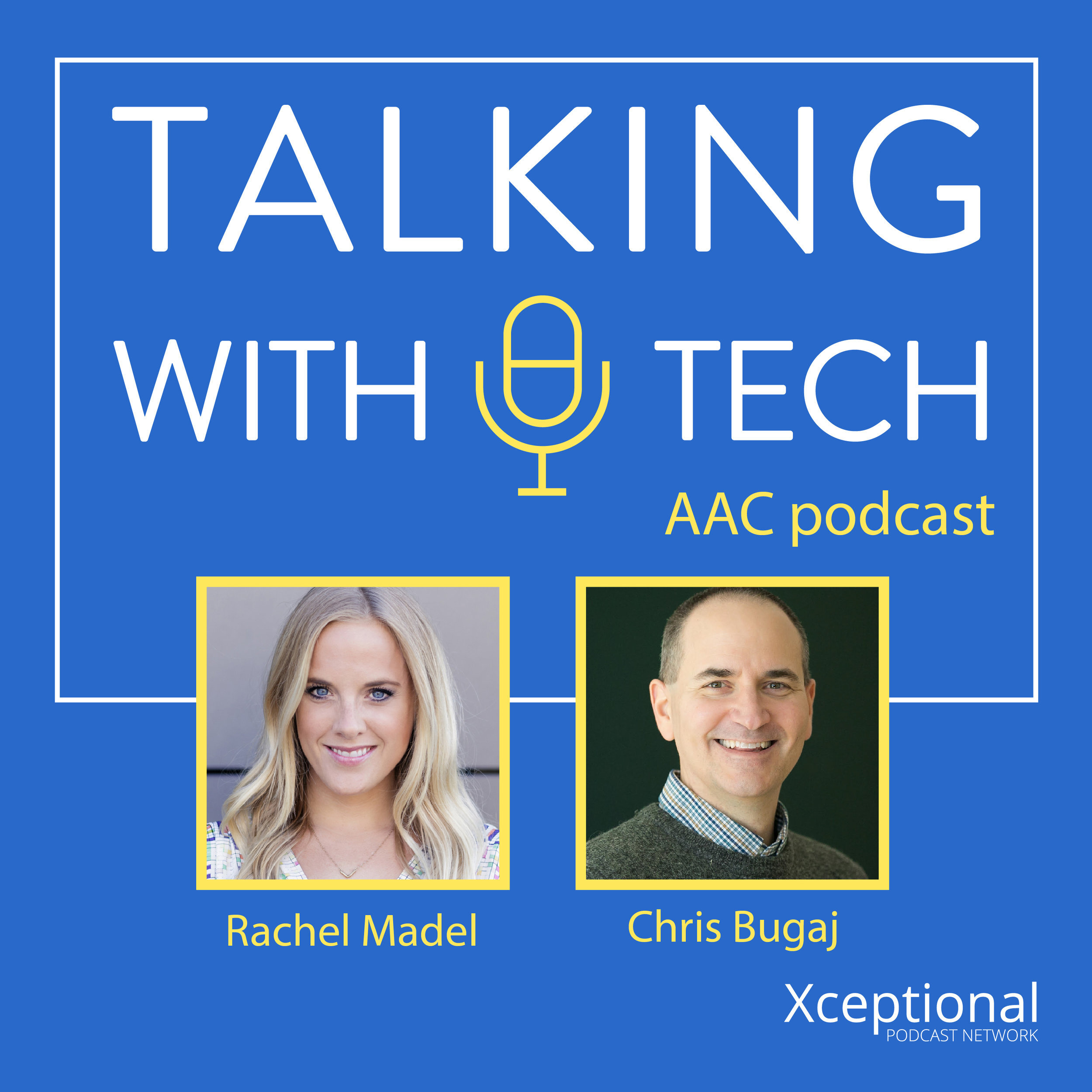
Join AAC experts Rachel Madel and Chris Bugaj as they dive into a weekly discussion about all things AAC (Augmentative and Alternative Communication). Every episode they deliver practical resources, clinical guidelines and relevant research to help clinicians better utilize technology for individuals with complex communication needs.
Episodes include interviews with industry thought-leaders, clinicians, parents, researchers and app developers to keep you on the pulse of the educational technology scene and better support communication through the use of technology.


